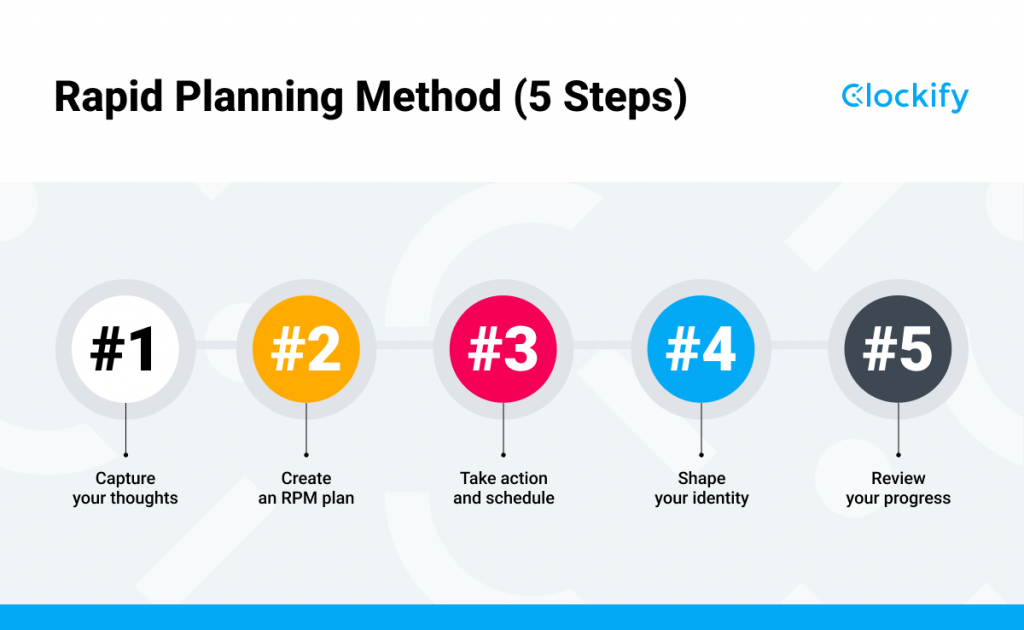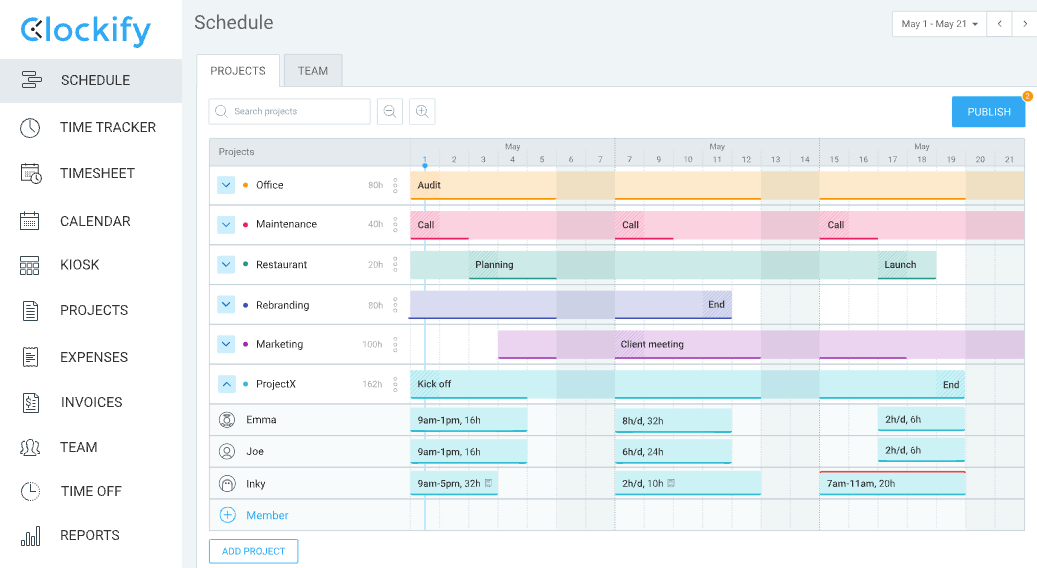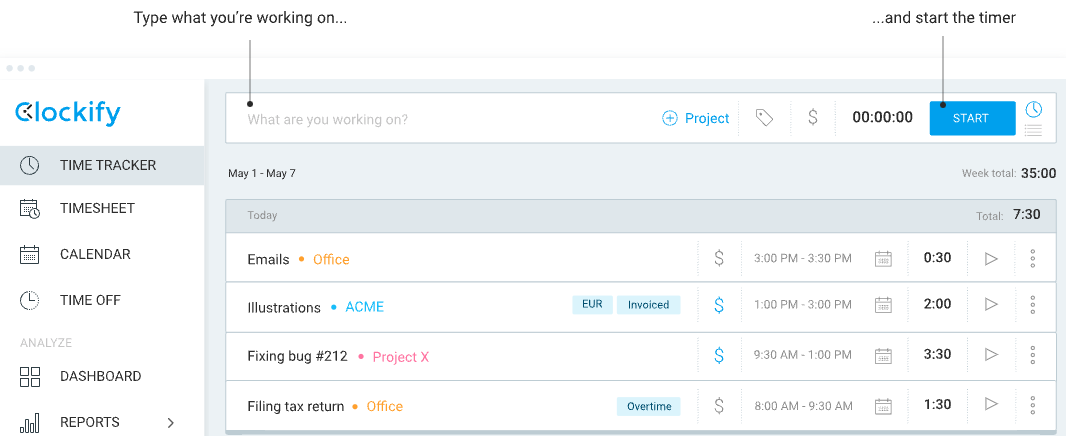If the very thought of the things you have to do each day gets you an instant headache, or you repeatedly fail at goal-setting — I highly recommend you stick around and read this blog post.
In this blog post, I’ll introduce you to a whole new way of getting things done and reaching your goals — with the help of the Rapid Planning Method. Not only does this method help you achieve your goals, but it also teaches you ways to focus on what matters.
Here’s a brief overview of what you can read about in this text, which includes:
- RPM definition
- How to create an RPM plan (+ Example)
- RPM personal observations and thoughts
What is the Rapid Planning Method (RPM)?
The Rapid Planning Method, as its creator Tony Robbins points out, is a system of thinking — not a time management technique per se.
In a nutshell, RPM helps you stay focused on a particular outcome by guiding you through different steps to make it happen. Instead of doing more and more, the emphasis is on deciding precisely what to do and doing it right.
The RPM system really does change the way you think about your desired outcomes — but, in a new and eye-opening way. Tony Robbins believes people adopt a wrong attitude about the things they must or should do, right from the beginning.
For instance, you want to complete a task, but you’re only thinking about how demanding it will be or how long it will take. The RPM system shifts your focus on what you want to achieve, i.e. the final outcome. This way, you can brush aside all the nuisances and problems that come along the way.
When I started writing this blog post, the first thing that came to mind were those war movies in which soldiers endured hardships just by thinking about their homes, spouses, and children, by looking at the photos of their loved ones.
This is what kept them going — focusing on what they really wanted, their final goal — to come back home to their loved ones. Everything in between didn’t matter.
As Tony himself says: Focus equals power.
Breaking down the Rapid Planning Method (RPM)
Even though RPM means Rapid Planning Method, the acronym also stands for:
- Results-oriented — Explains WHAT you really want to achieve (What is my final goal?)
- Purpose-driven — Helps you find a reason WHY you want to do something (What are my reasons and motives for doing that?)
- Massive action plan — Tells you HOW to do it (What do I need to do to accomplish this? What’s my plan?)
Therefore, before you start realizing a plan, ask yourself said questions — but bear in mind that the sequence of these questions is critical. No matter if you are planning your daily activities, a project, or a long-term goal — start by asking yourself these three questions following this specific order. According to Tony, when you know the desired result first, followed by a compelling reason for doing something, you will figure out how to pull it off eventually. That is the only way to succeed at achieving your goal — to know what, why, and how you are going to do it.
Rapid Planning Method example
Let’s incorporate the RPM system into one real-life example. Remember — avoid vague phrasing and be specific.
❌ Poor example: I want to improve my time management skills.
The first example is bad since it’s too vague, i.e. it only defines a broad goal but no purpose behind it or how to achieve it.
✅ Good example: I want to improve my time management skills to increase productivity at work, beat procrastination, and do more with less time by building the habit of tracking time.
Here, on the other hand, we have a precisely defined goal together with the reasons behind it and a concrete plan on how to achieve it.
How to create your RPM plan
Now it’s time to guide your goal in the right direction.
For a better insight into the RPM method itself, we’ll refer to the previously mentioned example concerning improving one’s time management skills and expand on it.
There are 5 steps that will help you create a successful RPM plan for achieving your final outcome:
- Capture your thoughts
- Create an RPM plan
- Take action and schedule
- Shape your identity
- Review your progress

Step #1: Capture your thoughts
When thinking about your goal, it’s important to brainstorm your ideas to precisely define what you want to achieve. Simple pen and paper always work! Try making a list of things you want to achieve and capture the ideas you consider most worthy.
When there are too many items on your list, chunk them down into groups such as health, career, relationships, or any other custom-made category, to sort your thoughts.
To move back to our specific example, the idea is:
To improve my time management skills.
Step #2: Create an RPM plan
To create an achievable plan for your specific goal (or goals), you’ll need to answer the following questions (in this specific order):
- RESULT (R) — Be specific about the result you are after.
- “What do I want to achieve?” → “I want to improve my time management skills.”
- PURPOSE (P) — Whenever you do something, there must be a reason why you do it. When you identify the reason, you have a much bigger chance of success.
- “Why do I want this?” → “Because I wish to increase productivity at work, beat procrastination, and do more with less time.”
- MASSIVE ACTION PLAN (M) — Now that you know what you want to achieve and the reason behind it, it’s time to determine your massive action plan.
- “What must I do to achieve my desired results?” →
- Find some popular productivity books to read.
- Keep a to-do list and/or a planner.
- Avoid multitasking.
- Track my time using a time tracking app.
- Learn how to prioritize tasks.
- Make a schedule and stick to it.
- Identify distractions.
- “What must I do to achieve my desired results?” →
At first, it can be hard to break bad habits, change routines, and the way you think.
However, when you have a purpose on your mind — in this case, to increase productivity at work, beat procrastination, and do more with less time — the focus shifts to what really matters, and it’s easier to bear any dreary and demanding tasks on your way to achieving the goal.
The RPM Planning Block for your goal (in this case, to enhance your time management skills) should look like this:
| RESULT What do I want to achieve? | PURPOSE Why do I want this? | MASSIVE ACTION PLAN What must I do to achieve my desired results? |
|---|---|---|
| – Improve my time management skills. | – To be more productive at work. – To beat procrastination. – To get more done in less time. | – Avoid multitasking. – Keep a to-do list. – Use a time tracking app. – Learn how to prioritize. |
Step #3: Take action and schedule
Now that you know what you want to achieve, why you want it, and have a plan on how to do it — it’s time to roll up your sleeves and take action!
When you have multiple things to do in a day, it’s wise to prioritize your tasks accordingly. Furthermore, schedule a specific time in your calendar to ensure you don’t omit an item from your to-do list.
Again, make use of technology and organize your schedule with Clockify.

This is what scheduling looks like in Clockify. There’s a clear insight into your daily, weekly, or monthly tasks and goals. You can use it for both work and personal life as it allows you to:
- Add or remove projects/tasks,
- Easily manage assignments,
- Choose start and end time,
- Share your schedules with others, and more.
Furthermore, start tracking your time regularly, and make it a habit. Here is what tracking time in Clockify looks like:

You can start and stop the timer as you work, or enter hours manually. Whichever works best for you.
Step #4: Shape your identity
I find this step to be most motivating and thrilling. What you need to do here is create an identity term for each specific result you are after. It shifts your attention from all the dreary tasks you must complete and the sacrifices you must make to reach the outcome.
To go back to our example, working on your time management is not something that happens over night. It’s something that requires continuity and an iron will to break old habits and form new routines. To begin with, don’t think of yourself as a procrastinator or laggard. Instead, shape your identity in a way that will give you motivation and help you stay on track with your final goal.
Think of something empowering, such as the master of time, for instance. When you think of yourself as the master of time, you forget about all fears and obstacles that are standing between you and your success.
Your newly shaped identity will change how you feel about yourself, keep you motivated, and, most importantly — shift your focus on the final outcome.
Step #5: Review your progress
Last but not least — don’t forget to celebrate your accomplishments and review your progress.
Maybe you can measure your success by looking back at the things you used to manage to accomplish and all the things you get done now.
This will motivate you to move further and maybe even turn your RPM plan up a notch!
Rapid Planning Method: Why I decided to try RPM
Now, if you think that the example with improving time management skills is just a random example — think again. In the past, I struggled with staying on top of my workload including poor organization, procrastinating, and worst of all, poorly managing my most valuable asset — time.
I even tried incorporating some techniques that I stumbled upon on the Internet to improve my productivity, such as doing the most demanding tasks first, waking up early, and similar.
Yet, I would end up slipping back into my old habits of poor organization and procrastinating eventually.
I’m not saying waking up early is a bad thing — but the problem is that I had never questioned if I am really a morning person, and if such work style truly works for me.
I would wake up early but end up being stressed due to working late to meet my deadlines.
A little more than five months ago, I decided to shake things up. No more ‘try the perfect time management strategy’ or ‘increase your productivity with these 5 steps’ and similar. Those things would always lead to instant results, and the old habits would boomerang back eventually.
I needed something deeper — something that would stick permanently and increase my self-awareness.
With that in mind, I stumbled on an appealing text about the Rapid Planning Method, and I thought to myself: “Why wouldn’t I use this mode of thinking to improve my time management skills?”
So, I did. I used the above plan to achieve my goal.
Since I’ve already walked you through each step of RPM viewed through my lens — I’m going to share some insights about how it affected me and the final results.
Rapid Planning Method (RPM): My observations
After some time of using the RPM methodology to achieve my desired outcome (i.e. a little more than five months), I may say that RPM opened a whole new perspective on goal-setting.
Prior to RPM, I always struggled with continuity and never really achieved long-lasting results.
On that account, these are some of the most notable advantages of the Rapid Planning Method from my experience:
- Helps you understand what you want — RPM trains your brain to stay focused on the outcomes you are after. With RPM, you understand what you want and why you want it.
- Makes planning more manageable — The RPM methodology breaks your goals into more manageable tasks hence making them easier to plan and prioritize.
- Changes your mindset — As mentioned above, RPM is a system of thinking, and as such, it shifts your mindset in a way that you forget about fears and hardships and start living your full potential.
- Boosts your confidence — This methodology offers a unique way of turning your negative beliefs about yourself into positive ones.
- Documents your progress — To stay on track and focus on your goals, RPM makes sure you review your progress — see if what you did so far was successful or needs improvement.
Rapid Planning Method (RPM): My results and final thoughts
I may say that no matter which technique or method you use to accomplish something in life, if you don’t change your perception first — your goals and desires are doomed to failure at some point.
Remember — positive thoughts can move mountains.
Perhaps the most valuable lesson that RPM taught me is to believe in myself and my potential.
What I found extremely odd at first was building a habit of using a time tracking app to measure my time. Turning on a time tracker app each time I would start doing something was preposterous to me at that point. But, it’s incredible how you get used to it so quickly, and how, as soon as you press that ‘start’ button, you just want to get to work and make every minute count.
As far as my results are concerned, I may say that it took me a while to adjust to new changes and adhere to them religiously. Now, I don’t rush blindly into trying out numerous time management techniques, I get more things done without feeling burned out, and the habit of tracking my time sticks with me even when I’m doing some minor tasks around the house.
What keeps me going is the fact that now I never struggle to meet deadlines, my days run smoothly, I manage to do everything I plan in a day — efficiently and most importantly, stress-free.
I don’t want to think of myself as a laggard who can’t do anything right anymore. RPM helped me create a new, exciting, and empowering identity that I’m proud of. Now, I am the master of my time.
Yes, it does take time and effort to adopt this system of thinking and put it into practice, but once you do, you’ll be able to get ten times the results. Finally, I’m giving RPM a well-deserved five-star rating!
FINAL RATING: ⭐⭐⭐⭐⭐
Wrapping up: RPM brings out the best in you
I would sincerely recommend the Rapid Planning Method to anyone who struggles to accomplish something in life — be it minor daily tasks, improving skills, or life-changing goals.
RPM will change the way you think in order to focus on the results you are after.
Self-doubt and unmet goals will become a matter of the past — at least that’s what happened to me.



